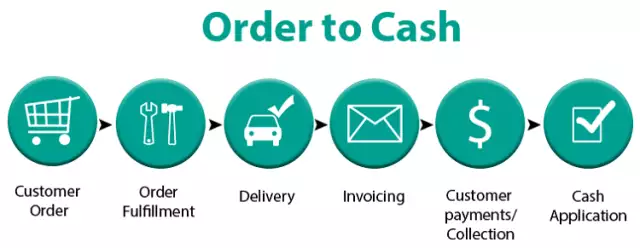
The ultimate guide to order-to-cash (OTC): Everything you need to know

Gaining new customers for your business is a big accomplishment that requires cross-functional effort by numerous teams. However, the hard work doesn’t stop when you close the deal or a customer places their initial order. In fact, that’s just the tip of the iceberg, and what comes next can be even more complex. This part of the end-to-end business lifecycle is called order-to-cash.
What is order-to-cash?
Order-to-cash, also referred to as OTC or O2C, is the set of business processes that’s concerned with receiving customer orders and fulfilling their requests for goods and services.
Simply put, OTC encompasses the entire lifecycle of order fulfillment. The order-to-cash process includes all actions required to process customer orders and deliver the products and services to fulfill those orders. It involves numerous business functions such as inventory management, operations, and production.
The order-to-cash process
OTC begins when a customer order is received. Once the order is processed, the next steps include strategizing your supply chain to get products from stock or manufacturing, preparing products for shipment, and delivering them to the customer.
After the product has shipped successfully, the final stages of the OTC process begin. These include invoicing the customer, collecting payments, and recording the revenue in your general ledger (back-end ERP).
Steps within the order-to-cash cycle
There are many ways to break down the OTC cycle, but these are the six primary steps in the process:

1. Customer order
The OTC process begins as soon as a customer places an order. Whether the order comes through your ecommerce platform, a signed contract, or an email to the sales team, the order management processes should kick in as soon as the purchase is confirmed.
2. Order fulfillment
After the order is placed, the company prepares the order for shipment (or schedules the service appointment). Larger companies typically rely on technology to streamline order fulfillment—for example, using instant order notifications and automated inventory management software.
3. Delivery
The order is then shipped to the customer (or the service is provided at the agreed-upon time). Timely delivery is critical to customer satisfaction, which makes it an important part of the order-to-cash process.
4. Invoicing
Once the product or service is delivered, the company generates and sends an invoice to the customer for payment. Invoice problems can have a direct impact on cash flow, so it’s crucial to minimize delays and inaccuracies.
5. Payment collection
Payment for the product or service is received from the customer. Automation can help ensure timely payment—for example, you can generate payment reminders before the payment becomes overdue.
6. Cash application
When payment is received, it must be recorded in the company’s accounting ledger. This final step brings the order-to-cash process to a close.
The difference between order-to-cash and quote-to-cash
If the OTC process starts with a customer purchase and continues through revenue recognition, what makes it different from the quote-to-cash (QTC) process?
Despite some similarities, quote-to-cash encompasses a larger set of business processes, spanning from a customer’s intent to purchase a product or service through the realization of revenue. More specifically, OTC differs from QTC in two important ways:
- OTC does not include configure, price, quote processes (CPQ).
The OTC process does not include configuring the product or service, setting a price, or creating and sending a quote. All of these things happen prior to the OTC process.
Configuration, pricing, and quoting are the first stages of the larger quote-to-cash process. Deciding on the best fit of product and service bundles for potential customers requires accurate pricing and quoting information—aspects that play a major role in deal sizes and cycle times. An intelligent CPQ solution will help shorten cycle times and increase deal size by directing reps to the best products and pricing, while providing intelligent upsell recommendations based on past deals.
- OTC does not include contract lifecycle management.
Contracts are the backbone of any business, and while the OTC process uses data from customer contracts, contract creation and negotiation occur outside the order-to-cash cycle. Quote-to-cash, on the other hand, incorporates all contract management processes, including contract creation, negotiation, execution, and revenue management. Effective contract management in the QTC process can result in shorter contracting cycles, an increased acceptance rate, higher compliance, and lower administrative costs.
Order-to-cash is focused on order fulfillment and effective order delivery, but it’s only one piece of the puzzle. Quote-to-cash is a much larger process that encompasses the order to cash process, as well as CPQ and contract management.
The difference between order-to-cash and procure-to-pay (P2P)
Procure-to-pay (P2P) is another important process for many companies, but it’s very different from OTC. As we’ve already explored, OTC deals with customers, order fulfillment, and accounts receivable. P2P is essentially the mirror image of OTC, encompassing processes related to vendors, procurement, and accounts payable.
Effective P2P processes are essential for businesses that rely on external suppliers for materials, goods, and services. The fundamental steps in the P2P process include:
- Sourcing the necessary goods or services
- Creating a purchase order
- Receiving approval for the purchase order
- Receiving the goods or services
- Receiving an invoice from the vendor
- Paying the invoice
Why the order-to-cash process matters
The OTC cycle involves many critical business functions, including supply chain management, inventory control, accounts receivable, and more. Bottlenecks at any point in the order-to-cash process can have a significant impact on business results.
To optimize the OTC process, it’s critical to ensure that each party in the OTC lifecycle has access to accurate, real-time information at any given moment. The right technology—including integrated software for order management, inventory management, fulfillment automation, invoicing, accounting, collections, and reporting—can also help to maximize OTC efficiency and drive better business results.



